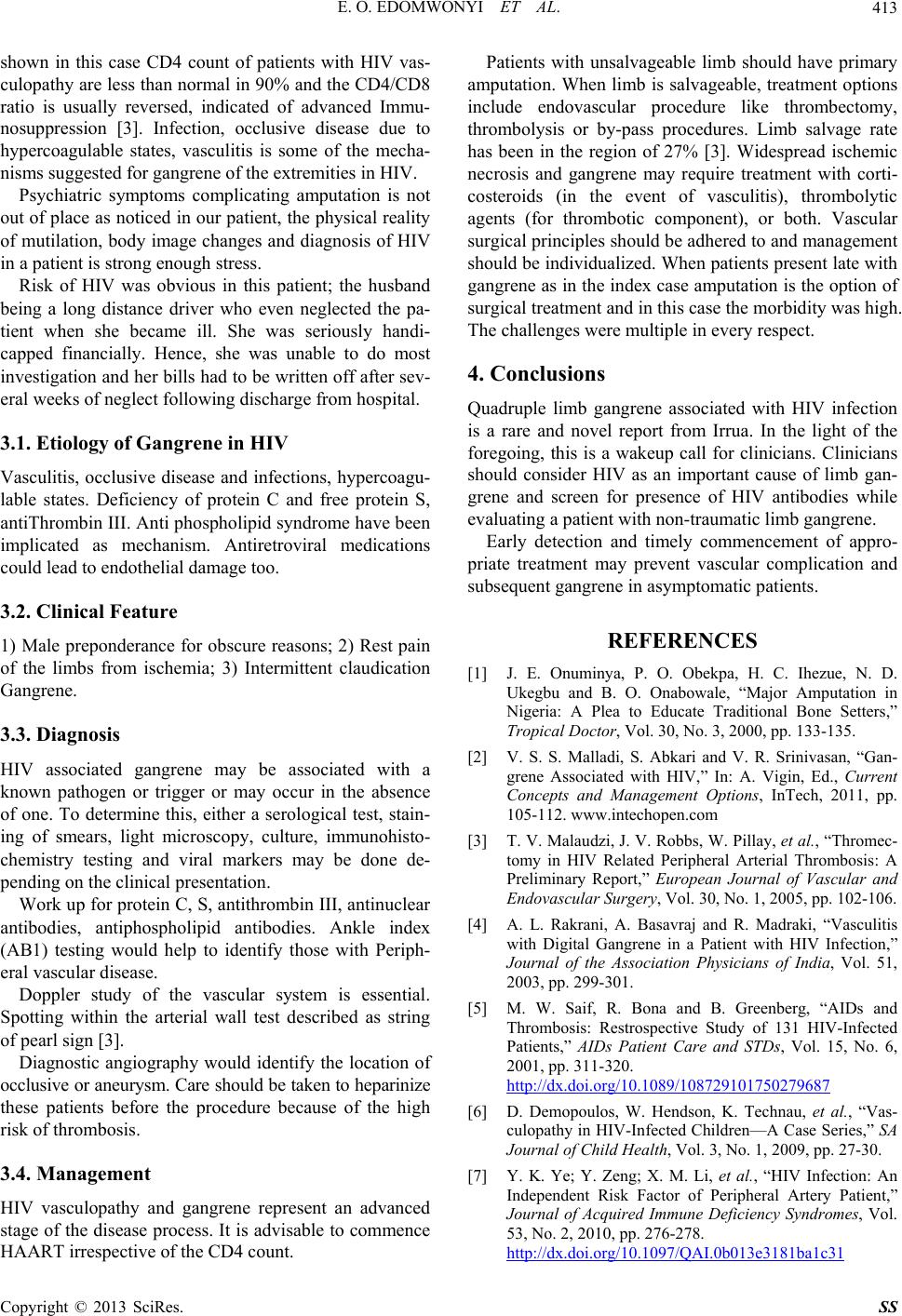
E. O. EDOMWONYI ET AL. 413
shown in this case CD4 count of patients with HIV vas-
culopathy are less than normal in 90% and the CD4/CD8
ratio is usually reversed, indicated of advanced Immu-
nosuppression [3]. Infection, occlusive disease due to
hypercoagulable states, vasculitis is some of the mecha-
nisms suggested for gangrene of the extremities in HIV.
Psychiatric symptoms complicating amputation is not
out of place as noticed in our patient, the physical reality
of mutilation, bod y image changes and diagnos is of HIV
in a patient is strong enough stress.
Risk of HIV was obvious in this patient; the husband
being a long distance driver who even neglected the pa-
tient when she became ill. She was seriously handi-
capped financially. Hence, she was unable to do most
investigation and her bills had to be written off after sev-
eral weeks of neglect following discharge from hospital.
3.1. Etiology of Gangrene in HIV
Vasculitis, occlusive disease and infections, hypercoagu-
lable states. Deficiency of protein C and free protein S,
antiThrombin III. Anti phospholip id syndrome have been
implicated as mechanism. Antiretroviral medications
could lead to endothelial damage too.
3.2. Clinical Feature
1) Male preponderance for obscure reasons; 2) Rest pain
of the limbs from ischemia; 3) Intermittent claudication
Gangrene.
3.3. Diagnosis
HIV associated gangrene may be associated with a
known pathogen or trigger or may occur in the absence
of one. To determine this, either a serological test, stain-
ing of smears, light microscopy, culture, immunohisto-
chemistry testing and viral markers may be done de-
pending on the clin ical presentation.
Work up for protein C, S, antithro mbin III, antinuclear
antibodies, antiphospholipid antibodies. Ankle index
(AB1) testing would help to identify those with Periph-
eral vascular disease.
Doppler study of the vascular system is essential.
Spotting within the arterial wall test described as string
of pearl sign [3].
Diagnostic angiography would identify the location of
occlusive or aneurysm. Care should be taken to heparinize
these patients before the procedure because of the high
risk of thrombosis.
3.4. Management
HIV vasculopathy and gangrene represent an advanced
stage of the disease process. It is advisable to commence
HAART irrespective of the CD4 count.
Patients with unsalvageable limb should have primary
amputation. When limb is salvageable, treatment options
include endovascular procedure like thrombectomy,
thrombolysis or by-pass procedures. Limb salvage rate
has been in the region of 27% [3]. Widespread ischemic
necrosis and gangrene may require treatment with corti-
costeroids (in the event of vasculitis), thrombolytic
agents (for thrombotic component), or both. Vascular
surgical principles should be adhered to and management
should be individu alized. When patien ts present late with
gangrene as in the index case amputation is the option of
surgical treatment and in this case the morbidity was high.
The challenges were multiple in ev ery respect.
4. Conclusions
Quadruple limb gangrene associated with HIV infection
is a rare and novel report from Irrua. In the light of the
foregoing, this is a wakeup call for clinicians. Clinicians
should consider HIV as an important cause of limb gan-
grene and screen for presence of HIV antibodies while
evaluating a patient with non-traumatic limb gangrene.
Early detection and timely commencement of appro-
priate treatment may prevent vascular complication and
subsequent gangrene in asymptomatic patients.
REFERENCES
[1] J. E. Onuminya, P. O. Obekpa, H. C. Ihezue, N. D.
Ukegbu and B. O. Onabowale, “Major Amputation in
Nigeria: A Plea to Educate Traditional Bone Setters,”
Tropical Doctor, Vol. 30, No. 3, 2000, pp. 133-135.
[2] V. S. S. Malladi, S. Abkari and V. R. Srinivasan, “Gan-
grene Associated with HIV,” In: A. Vigin, Ed., Current
Concepts and Management Options, InTech, 2011, pp.
105-112. www.intechopen.com
[3] T. V. Malaudzi, J. V. Robbs, W. Pillay, et al., “Thromec-
tomy in HIV Related Peripheral Arterial Thrombosis: A
Preliminary Report,” European Journal of Vascular and
Endovascular Surgery, Vol. 30, No. 1, 2005, pp. 102-106.
[4] A. L. Rakrani, A. Basavraj and R. Madraki, “Vasculitis
with Digital Gangrene in a Patient with HIV Infection,”
Journal of the Association Physicians of India, Vol. 51,
2003, pp. 299-301.
[5] M. W. Saif, R. Bona and B. Greenberg, “AIDs and
Thrombosis: Restrospective Study of 131 HIV-Infected
Patients,” AIDs Patient Care and STDs, Vol. 15, No. 6,
2001, pp. 311-320.
http://dx.doi.org/10.1089/108729101750279687
[6] D. Demopoulos, W. Hendson, K. Technau, et al., “Vas-
culopathy in HIV-Infected Children—A Case Series,” SA
Journal of Child Health, Vol. 3, No. 1, 2009, pp. 27-30.
[7] Y. K. Ye; Y. Zeng; X. M. Li, et al., “HIV Infection: An
Independent Risk Factor of Peripheral Artery Patient,”
Journal of Acquired Immune Deficiency Syndromes, Vol.
53, No. 2, 2010, pp. 276-278.
http://dx.doi.org/10.1097/QAI.0b013e3181ba1c31
Copyright © 2013 SciRes. SS